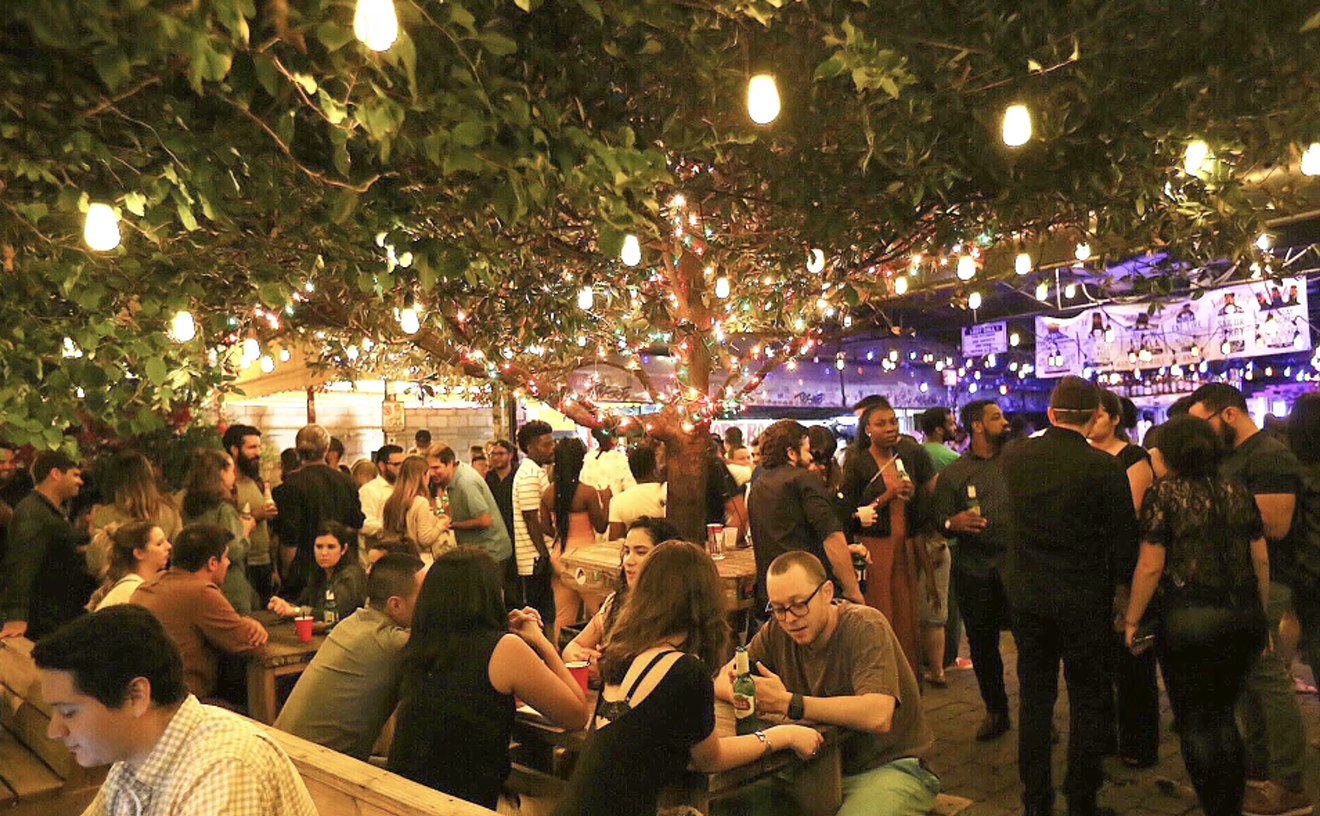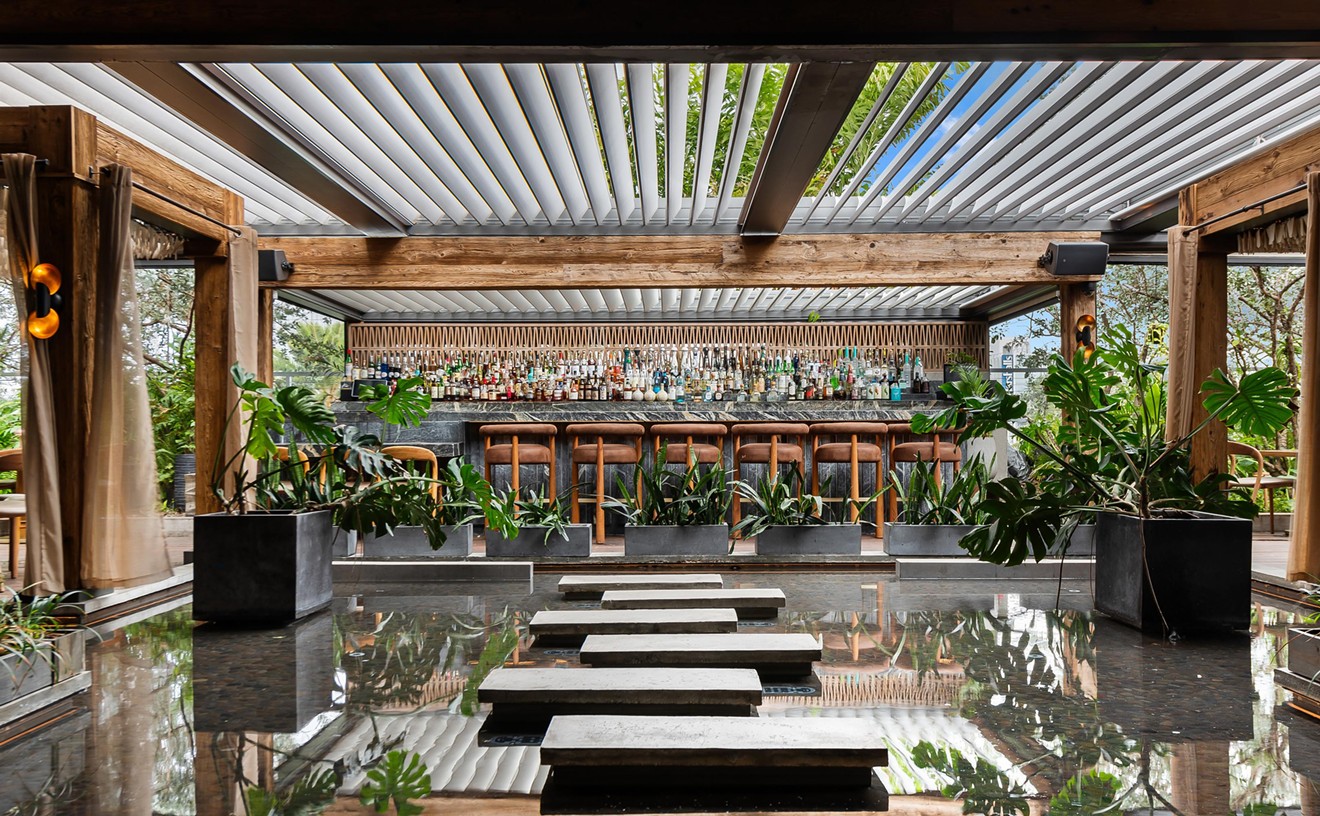We were discussing the "dramatic erosion of Latin culture" he has observed in the second generation of Cuban Americans. A poet, art critic, and professor of English at Miami-Dade Community College, Pau-Llosa's two most recent books of poems (Bread of the Imagined and Cuba) explore the controversial issue of political exile, and he has a unique perspective on Cuban refugees here in Miami. Born in Havana in 1954, he emigrated to Chicago with his family when he was six, then moved to Tampa and finally to Miami when he was fourteen. "The fear that there is no assimilation is absurd," he says. "Despite large chunks of refugees, most Cuban Americans know zero percent of their own culture. They identify themselves as Cuban but know little about what it means to claim their heritage. If you're going to make that connection, you need to know the basics."
It was, perhaps, deliberately ironic that we were debating identity over dinner at Doc Dammers. The 100-seat restaurant, located in the lobby of the Omni Colonnade Hotel in Coral Gables, used to be an American-style meatery complete with a rolling cart filled with cuts of beef. But business was falling off, and management felt the place was too high-end. So a year ago executive chef Mark Dekrines was brought on-board to tailor the restaurant to the Gables's Latin community. Now, while you can still tear apart a sirloin burger or grilled steak sandwich for lunch, "Miami nueva cuisine" is the order of the night.
Dekrines, who worked under Allen Susser at Chef Allen's, has some interesting ideas about borrowing influences from South American and Caribbean nations. But many of his dishes sound better on paper than they actually taste on the plate; the two times I visited, execution was off. What's more, the Latin vibe seems altogether wrong for this place. Edward E. "Doc" Dammers, from whom the restaurant appropriated its name, was an American land baron who parceled out the swampy pieces of Coral Gables in 1910 (preceding George Merrick's development of the "City Beautiful"). Authentic black-and-white photos of Dammers, dedicated to Dammers, or otherwise somehow related to Dammers hang on the walls of the high-ceiling, white-tiled dining room, which features clubby dark wood and green marble accents and looks like an extension of the hotel lobby. If Doc Dammers were to claim a past for itself, gaslights and continental cuisine might better reflect the early decades of this century. Or perhaps more rustic decor to round off the Miami-as-frontier theme. The menu notwithstanding, this restaurant is about as Latin American/Caribbean as Dadeland, and dining here is a somewhat dysfunctional culinary experience.
The waitstaff doesn't help. Though the switch has been in place for a year, servers still seem baffled; one waiter glibly volunteered the information that the menu was "turn-of-the-century cooking." When I asked what that meant, he stumbled around a bit before coming up with this pearl of wisdom: "Well, it's a primitive style -- you know, when people used to cook on hot slabs of rock. We've updated by using grills but kept the essence."
An appetizer like blue crabcake with lobster beurre blanc and crisp "rainbow" fries hardly seemed antediluvian (or even turn of the century, for that matter). More like New World. And second-rate: The "rainbow" was a salty and greasy pile of yam and boniato shoestrings hiding a pair of crabcakes that were tasty but could have used a bit longer in the pan to tighten them up and give them some crunch. The beurre blanc was flavorful but sugary, leaving an impression of artificial sweetness on the palate, and a menu-billed apple-banana garnish was absent.
Spicy Florida rock shrimp with pineapple mint relish, grilled radicchio, and a jicama salad sounded promising, and the juicy flavors of the salsa and salad were indeed refreshing. But the dish was marred by tiny, briny chunks of rock shrimp. Pan-seared fresh jumbo sea scallops were a vast improvement, succulent and tender. Warm pickled black beans, whole and ideally cooked, dotted the scallop seascape, though perfection eluded this dish as well: The triangles of pastry that decorated the recipe were brown and hard.
Beans again -- in a smoky Chilean bean chowder with chorizo that was decent despite being served lukewarm. Navy and pinto beans, along with chunks of chorizo that tasted more like tame ham, had been stewed with carrots and celery. Request a twist of fresh black pepper to give this some much-needed heat.
Pungency returned in the form of a ravioli starter. This was one long sheet of pasta, more like a lasagna noodle than a dumpling, covering a filling of duck and crumbled chorizo that was robust but dried out. On top, herb-seared wild mushrooms contributed salty appeal, but a Brazilian orange sauce was rife with enough garlic to scare away Anne Rice.
A few appetizers -- the scallops and the crabcakes, as well as a South American bouillabaisse -- reappear as entrees, a practice (often found on hotel room-service menus) that makes the selection of entrees look longer and more interesting than it actually is. Among the other main courses, a fillet of black grouper baked in a fufu (mashed plantain) crust was bland and overcooked, and accented with an unappealingly brownish papaya guacamole. ("Insipid," declared my companion Pau-Llosa.) The chef's rice pilaf tasted like soy sauce and gave the dish an ill-suited Asian tang.
A fillet of salmon was a fresh, flaky piece of fish, though I didn't care for the thin-shaved, blackened boniato in which it was wrapped. Nor did I enjoy the braised field greens, sprinkled with too much vinegar and salt, that accompanied the fish as a side dish. A calabaza sauce was interesting; though a bit too thick in texture to be truly a sauce, the pureed Caribbean pumpkin was delicious.
Baked calabaza crescents lent vibrancy to the kitchen's best effort, an Andean osso buco of lamb. This large lamb shank had meat literally falling off the bone in juicy hunks. A wine-rich sauce highlighted by caramelized pearl onions and minced root vegetables was aromatic and good cover not only for the meat but for the old and wrinkly oven-roasted red potatoes that rode shotgun.
The lamb nearly made up for a disaster of a "gaucho steak," which would have been wonderful had it not been salted to supersaturation. The beef was fragrant and rich, gently helped out by a sweet potato puree. Unfortunately, the lime chimichurri that might have cut the salt a bit was inedible, all garlic and oil instead of lime and parsley. An uninspiring partner of sauteed squash, carrots, onions, and peppers completed the plate and was echoed, along with the same ancient potatoes that came with the osso buco, on breast of chicken engordado. Stuffed with Serrano ham, Manchego cheese, and roasted red peppers, the rolled-up boneless chicken was stringy and arid.
Desserts sounded strangely American, including New York cheesecake, carrot cake, and the stale piece of chocolate cake I succumbed to. Bananas coated in pralines and covered with ice cream and caramel sauce were a slightly more tropical finish, but this sweet was simply soggy.
According to the restaurant's assistant manager Tom Stritter, business has improved since the eight-year-old Dammers went "Latin" to match the clientele. That may well be. But if we're talking posterity, "Miami nueva cuisine" surely doesn't reflect Doc Dammers's past -- and I'm pretty confident it doesn't represent its future either.
Doc Dammers Bar & Grill (in the Omni Colonnade Hotel) 180 Aragon Ave, Coral Gables; 569-6511. Open daily from 7:00 a.m. to midnight; Friday and Saturday until 1:00 a.m.
Smoky bean chowder
$5.00
Pan-seared sea scallops
$7.00
Salmon in boniato
$15.00
Osso buco of lamb
$15.00









